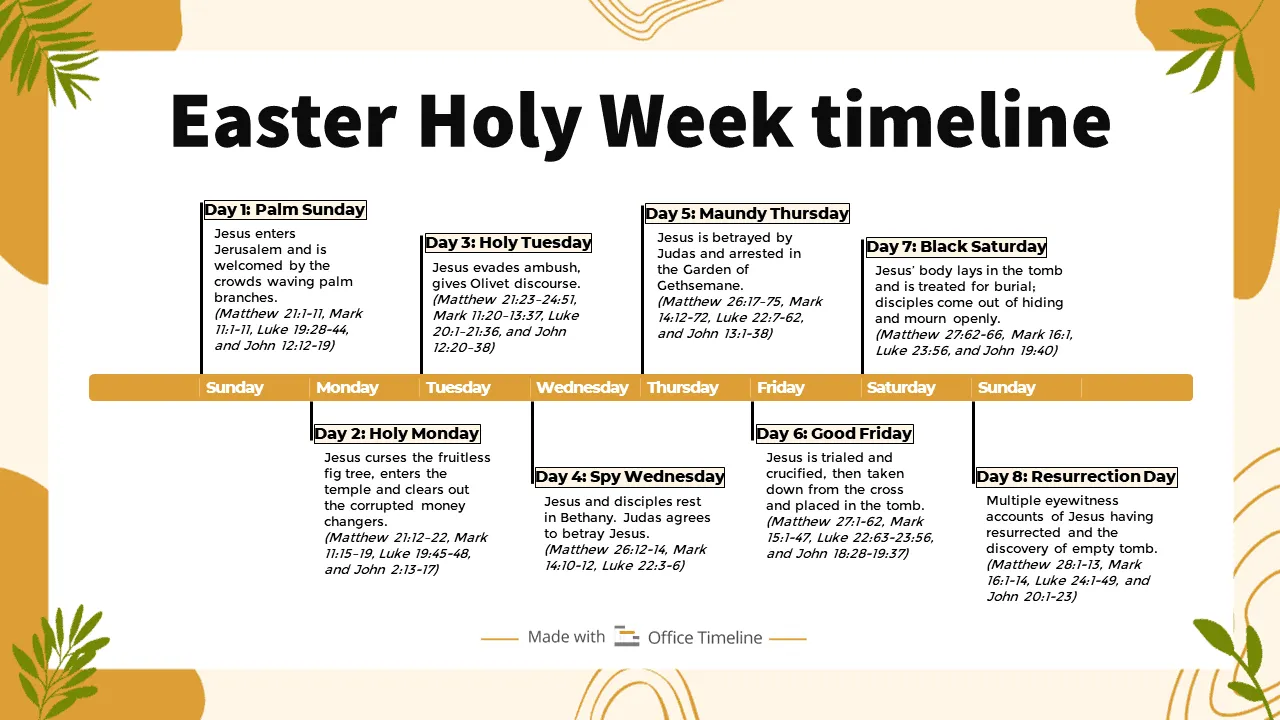Easter Holy Week timeline: the 8 days of Easter
Discover the timeline of events during the Easter Holy Week, from Palm Sunday to Easter Sunday. Free PowerPoint to download.
As the most important Christian celebration is right around the corner, we have created the Easter Holy Week timeline, based on the biblical accounts of Mark, Matthew, Luke and John. In addition, the blog post tries to provide answers to some of the most frequently asked questions about the holiday, its historical origins and significance.
Who knows, you might even find an Easter egg or two.
What do Christians celebrate on Easter?
Easter is also known as Latin and Greek Pascha, and it’s the most important religious holiday in Christianity. It commemorates the crucifixion and death of Jesus, followed by his resurrection from the dead, which the New Testament describes as having occurred three days after his burial. Christians see the willing oblation of Jesus as the ultimate sacrifice and a lesson in selflessness.
However, there is another key point here: Jesus’ story culminates with his triumph over death. Christians everywhere view the miraculous revival as proof that eternal life is granted to all true believers. Without it, there would be no Christian faith, and even the gospels (John 20:19, Corinthians 15:14 and Luke 24:39) report how the apostles grew disheartened following the events on Golgotha (Roman Calvary).
Yet, while there are variations in the story depending on the gospel, the resurrection of Jesus is the red thread connecting them all.
The origins of the word “Easter”
The English name for the holiday has similar words in German – Oestern – and Dutch – ooster – but the prevalent theory is that it comes from the Old English words “Ēastrun”, “Ēastre” or “Ēostre”. The illustrious 6th century Monk Bede writes that Ēosturmōnaþ – meaning “Month of Ēostre” – was the equivalent of April, named after the west Germanic goddess Ēostre who was celebrated in that month.
Is it “Pascha” or “Easter”?
In Latin and Greek, this holiday is still referred to as “Pascha”, which is derived from the Aramaic word “פסחא” (Paskha) and is related to the Hebrew “פֶּסַח” (Pesach). In the Jewish tradition, Pascha represents the festival of Passover, which commemorates the peoples’ exodus from slavery in Egypt. Nonetheless, the Orthodox Church uses the name “Pascha” to refer to the events of the resurrection.
When is Easter celebrated each year?
Easter – and associated celebrations – are known as “movable feasts”. The First Council of Nicaea did not establish a specific date for the holiday, but rather that it should be the same date all over the world (which didn’t stand up the test of time). Also, it should be determined regardless of the Jewish calendar.
As of such, the Gregorian calendar-wielding Western Christians decided that Easter should be celebrated in the interval from March 22nd to April 25th, seven days following the full moon. Eastern Orthodox Christians, who favor the Julian calendar, typically observe Easter between April 4th and May 8th.
FAQs about the Easter Holy Week timeline
Let’s have a look at some frequently asked questions about the Easter Holy Week and provide you with the answers you may be searching.
In the Christian tradition, the week leading up to Easter is known as the Holy Week, comprised of:
· Palm Sunday;
· Holy Monday;
· Holy Tuesday;
· Spy Wednesday;
· Maundy Thursday;
· Good Friday;
· Black Saturday.
In the New Testament gospels (Matthew, John, Mark and Luke) we can find descriptions of the events that culminate with the trial, crucifixion and resurrection of Jesus.
While some of these accounts aren’t 100% compatible, the general consensus is as follows:
1. Palm Sunday – Jesus triumphantly enters Jerusalem, where crowds greet him waving palm branches and, according to Mark 11:19-10, cry out “Hosanna! Blessed is the one who comes in the name of the Lord”.
2. Holy Monday – The gospels of Mark, Matthew and Luke describe cursing a fruitless fig tree in an event that’s omitted in the gospel of John; this gesture seems in stark contrast with Jesus’ personality, but religious scholars have interpreted it as a “prophetic act of judgement”. Jesus then enters the temple in Jerusalem and evicts the corrupted money changers, shouting: “My house shall be called the house of prayer; but ye have made it a den of thieves”.
3. Holy Tuesday – Mark 12:1-11 and Mark 12:1-2 tell us that Jesus preaches to the crowds in Jerusalem, but the audience also includes Pharisees, Sadducees, and other groups of Jewish religious leaders, who were displeased with his discourses. This could be explained by the fact that most of the parables were aimed directly at them.
4. Spy Wednesday – This day marks the arrangement between Judas and the high priests (the Sanhedrin) to betray and capture Jesus.
5. Maundy Thursday – Maundy is short for the Latin word “mandatum”, meaning “command”. According to John 13:1, this is when, during the Last Supper, Jesus gives his disciples a new commandment, that they should love one another as he has loved them. He also sets the framework for the Holy Communion.
6. Good Friday – Following the betrayal of Judas in the garden of Gethsemane, Jesus is trialed for the charges of subverting the nation and attempting to overthrow the Roman government. He is flogged, and ultimately crucified on the hill of Golgotha (Calvary). The body is taken down from the cross by Joseph of Arimathea.
7. Black Saturday – Except for Luke 23:56, none of the gospels talks about what the apostles were doing on the day after Jesus’ crucifixion. And even this is a passing mention about “resting on Sabbath, according to commandment”. It’s likely that they were meeting in secret, behind closed doors, fearing reprisals. Matthew 27:63-64 describes how the Jewish leaders went to the Roman governor Pontius Pilate and asked for the tomb of Jesus to be placed under guard, fearing the disciples would steal the body and fake the resurrection.
8. Resurrection Day – Neither of the four gospels describe the act of resurrection, but all of them (Mark 16, Matthew 28, Luke 24, Acts 1, and John 20) contain accounts of Jesus returning to his disciples on Sunday. There are also accounts surrounding the discovery of the empty tomb, the appearance of an angel and the women who met Jesus on the road. Nonetheless, the New Testament gospels all agree that: “He is Risen”.
The association of pagan symbolism with Easter can be considered intriguing, the Easter bunny being one example. We can trace the rabbit symbolism to pagan practices in 13th century Germany, where the Eostra – goddess of spring and fertility – was worshipped around the same time of the year. While Anglo Saxons did convert under the guidance of Pope Gregory’s missionaries, they retained some of the old customs as well.
About the Easter Holy Week timeline
The Easter Holy Week timeline is free to download as both an image and a PowerPoint file. The visual was created with Office Timeline, the perfect PowerPoint companion that helps you create amazing project visuals within minutes. Check out the free edition which includes most of the available features or give the free 14-day trial a go, in case you need to create more complex presentations.
“Happy Easter” from everyone here at Office Timeline!
Project management tips and tricks
Turn project data into professional timelines
Get the advanced features of Office Timeline free for 14 days.



